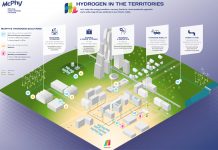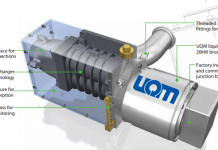Overview In light of oil prices reaching 60 to 70 dollars a barrel, attention is being paid to alternative energy technology, in the hope that it might answer our problems. The major role player right now, especially in terms of replacing combustion engines in cars and trucks, is the fuel cell industry. There are many types of commercially available fuel cells, ranging from ethanol to hydrogen. However, our readers and the public sometimes find it hard to keep up with all the technological terms and the latest inventions and research. This is a simplified summary of the science behind fuel cells, the types of fuel cells, as well as obstacles we face commercializing fuel cells and what companies are doing to overcome those obstacles.
What is a Fuel Cell?
A fuel cell is, as the name suggests, a compartment or a box-like structure that uses different methods to burn fuel and convert it to electricity. The ‘cell’ can be made of plastic or metal, depending on the contents of the cell. Even a combustion engine is a fuel cell that burns petroleum to produce electricity. However, fuel cells themselves can use a large variety of fuels for the same purpose. Inside the cell, the fuel is broken down to release electrons (electrical energy, if you will) that are captured in a built-in, causing a current to flow. In all fuel cells, there are certain chemicals produced as by-productsthey can either be harmful, or harmless. The conventional type of fuel cell that we speak of today is quite different from a combustion engine, or a solar cell. Fuel cells today specifically refer to machines that produce electricity using a fuel other than oil or gasoline, and do not use other alternative energies such as solar power.
Advantages of Fuel Cells
Most fuel cells that we know of produce little or no pollution. Little means that whatever pollution is produced, it doesn’t contribute to the overall greenhouse effect the way, say, gasoline combustion or fossil fuel usage would. For example, a hydrogen fuel cell, which splits hydrogen gas (or water) to produce electricity, produces nothing but water as a by product. An ethanol fuel cell produces carbon dioxide, a greenhouse gas that contributes 9-26% of the total greenhouse effect. However, there are biological sources of ethanol (i.e. compost, corn), and this way, carbon dioxide released does not increase greenhouse gas emissions.
Fuel cells have a wider range of uses than engines and batteries. Fuel cells can be scaled up to be used as stationary power plants, the way we use hydroelectric damns and wind mills now. In addition, fuel cells can be scaled down to a level that rivals batteries, and can be used to power cell phones, mp3 players and other common gadgets. It only gets betterfuel cells, especially hydrogen fuel cells, are being optimized to work as engines (a medium level scale) to power cars. GM has recently announced that it will release as many as 100 cars on to the road by 2007cars that will be powered only by hydrogen fuel cells.
Fuel cells have much higher efficiencies than combustion engines. Combustion engines average at around 30% efficiency, while fuel cells range between 45 and 70%
Some fuel cells are renewable. This means that the products of the reaction going on inside can be recycled into the same reaction. For example, hydrogen fuel cells split water to produce electricity, and the only by-product is water. Such a system could prove to be very cost effective and long lasting, as compared to batteries and engines, which consume fuel but cannot reuse it.
Obstacles We Face
1. Fuel cells are very expensive, not due to the fuel use, but due to the materials required to capture the electricity. Electrodes used in the circuitry are usually made up of platinum, a highly expensive and rather rare metal. Sometimes, fuel cells require membranes to separate their electrodes, and these membranes are very costly.
2. Certain fuels, such as methanol, are either toxic or very costly. Other fuels, such as hydrogen gas, are required in high volumes to be of any use. However, compacting hydrogen gas in a small container is an explosive hazard. In still other cases, obtaining the fuel from its basic sources is very expensive and even if the fuel itself is clean, obtaining it can be very polluting.
3. There is not much infrastructure available around the world to accommodate a large-scale change from typical energy sources (gas, fossil fuels, batteries) into fuel cells.
Solutions?
1. Although fuel cells are expensive, the costs are being brought down by using cheaper material in larger volumes (i.e. a cheaper carbon electrode that is larger, instead of a smaller, expensive platinum electrode). In addition, research in biotechnology is providing cheap materials that have similar properties to plastics and metals.
2. Toxic fuels can be replaced by those that are notsuch as replacing methanol, which is toxic, for its close relative, ethanol, which is harmless. Hazards can be avoided by engineering fuel cells to be more efficient, so that volumes of required fuel can be reduced. Biotechnology also helps in reducing the cost of producing the fuels. Certain bacteria and algae produce hydrogen gas naturally, which can be harvested at almost no extra cost. Ethanol fuel can be obtained from corn and sugar cane, a much cheaper process than obtaining it from other sources.
3. The only way to increase infrastructure is through the increased commercialization of fuel cell technology. As companies release more products, and as those products become popular, governments will naturally provide infrastructure (i.e. hydrogen pumps, instead of gas stations) to accommodate the rising demand. Money that is now used to reduce pollution released by fossil fuels can be instead used to build an infrastructure for cleaner fuels.
The Future
I believe that fuel cells have a very bright future, especially since they are cleaner and economic in the long term. There still is a lot of work to be done in research and in commercialization before fuel cells are used widely, however companies that are focusing their research and products on fuel cell technology have the potential flourish and succeed like never before. We can expect to see fuel cells becoming more efficient, cheap and we can also expect to see fuel cells hitting the market on a larger scale, perhaps within the next 10 to 15 years.







